Data - unarguably a valuable source of information – needs management. Without it, data can become corrupt or just wither unused.
If your business generates tons of data and you’re looking for ways to organize it for storage and further use, you’re at the right place. Read on to learn what components data management consists of and how to implement a data management strategy in your business. We’ll also talk about the data management platforms available on the market.
What is data management and why is it vital for business growth?
Data management is a set of practices for handling data collected or created by a company so that it can be used to make informed business decisions. The core idea behind the entire process is to treat data as a valuable asset — since that’s precisely what it is.
Well-designed data management processes can yield the following big benefits for your business.
Overall productivity improvement. If meticulously organized, data management minimizes data movement, helps uncover performance breakdowns, and enables users to have all the necessary information a click away.
Cost efficiency. With data management in place, a company can avoid unnecessary duplications and the employees won’t do the same research or fulfill the same tasks again and again.
Ability to rapidly respond to change. A company’s success depends heavily on its ability to make the right decisions quickly in case of change. If it takes too long to react to market shifts or activities of competitors, the business is likely to lose money and miss opportunities. Organized data allows decision-makers to acquire vital information faster and respond appropriately.
Enhanced accuracy of decisions. The more quality data you have, the bigger picture you see, and the better decisions you make. And vice versa, lack of information or errors in available data may lead to fatal business mistakes.
That said, let’s explore the main components of the overall data management process.
Data management components
The Data Management Association (DAMA) defines several large knowledge areas included in the end-to-end data management strategy. Each is incredibly important and deserves a dedicated article. Here we’ll give only a brief overview of these disciplines and specialists involved.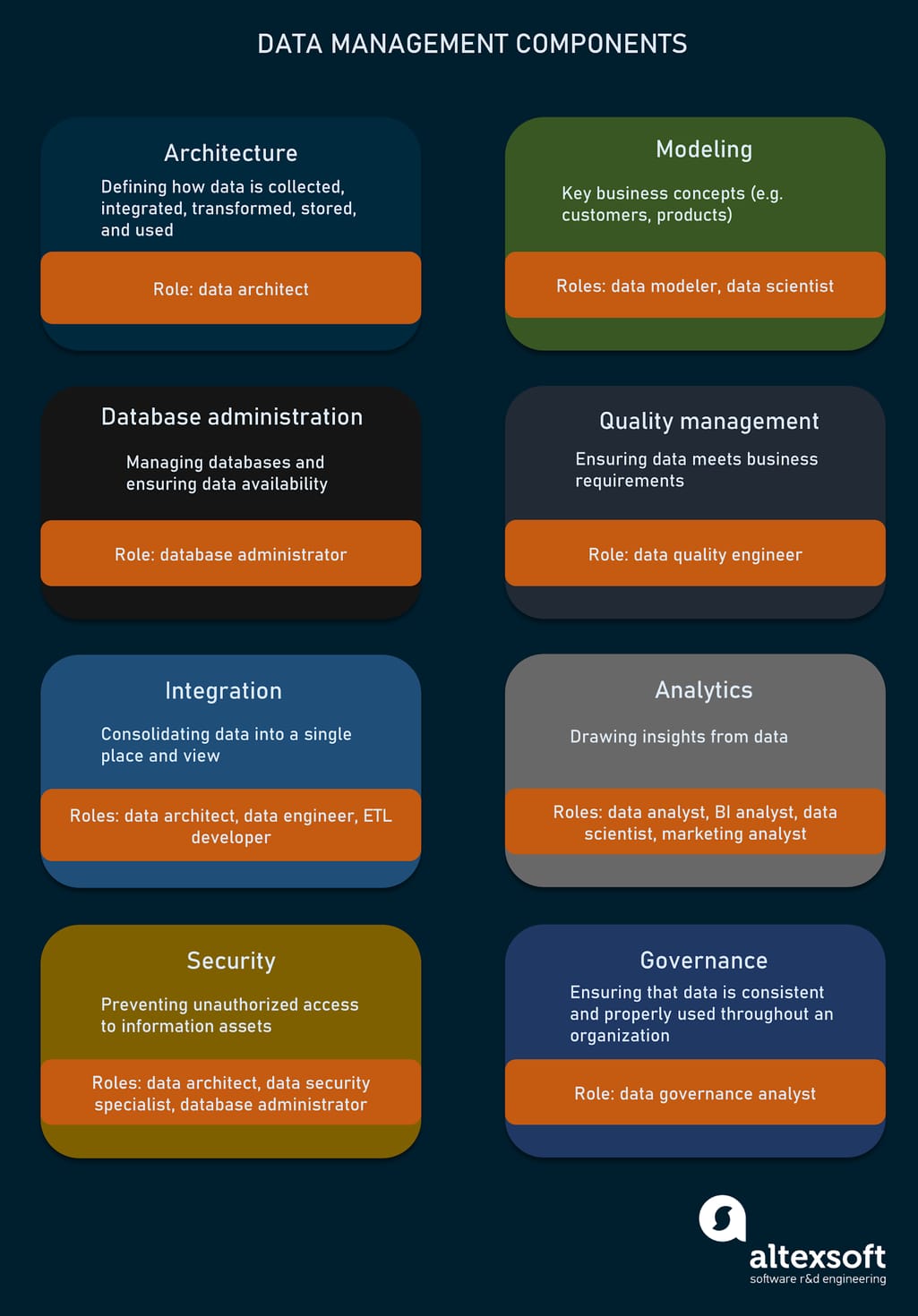
Key disciplines and roles in data management
Data architecture: aligning technologies with business goals
Specialist responsible for the area: data architect
Data architecture is a starting point for any data management model. Fitting into wider enterprise architecture, it outlines how data is collected, integrated, transformed, stored, and used. A data architect focuses on building a robust infrastructure so that data delivers business value.
The architect’s responsibilities include (but are not limited to) selecting the right software and hardware solutions, choosing between cloud-based and on-premises platforms, and enabling stakeholders to easily access the information they need for decision-making.
Data modeling: creating useful and meaningful data entities
Specialist responsible for the area: data modeler, data scientist
In its Guide to the Data Management Body of Knowledge, DAMA describes data modeling as “the process of discovering, analyzing, representing, and communicating data requirements in a precise form called the data model.”
Data modelers work closely with stakeholders to find out what data is useful for the company and build basic data entities (models) representing the core business concepts (for example, products and customers), their key attributes, and relationships between them. As a result, data is turned into an important business asset, while useful data entities can be efficiently stored, retrieved, and shared.

Data models translate business rules defined in policies into an actionable technical data system, Source: Global Data Strategy
Database administration: maintaining data availability
Specialist responsible for the area: database administrator
Database administration encompasses everything required to manage databases and ensure data availability. It includes monitoring database performance and making necessary configurations to achieve acceptable query response time. The functions of database administrators range from creating a database design to introducing updates to maintaining data security. They typically use Database Management Systems to automate various administration tasks.
Data integration and interoperability: consolidating data into a single view
Specialist responsible for the area: data architect, data engineer, ETL developer
Companies acquire data from multiple sources — manual entries, IoT devices, payment processors, CRMs, CMSs, eCommerce platforms, web and mobile analytics tools, social media. Scattered across different storages in various formats, data values don’t talk to each other.
We need data integration and interoperability to achieve connectivity between systems and consolidate content from disparate places into a single dataset to use for analysis and reporting. Without this part, it’s impossible to obtain accurate analytical results and extract valuable business insights.
There are two main approaches to data integration.
Extract, Transform, Load, or ETL process batches information and moves it from source systems to a data warehouse. Tools for these operations are designed or supervised by ETL developers.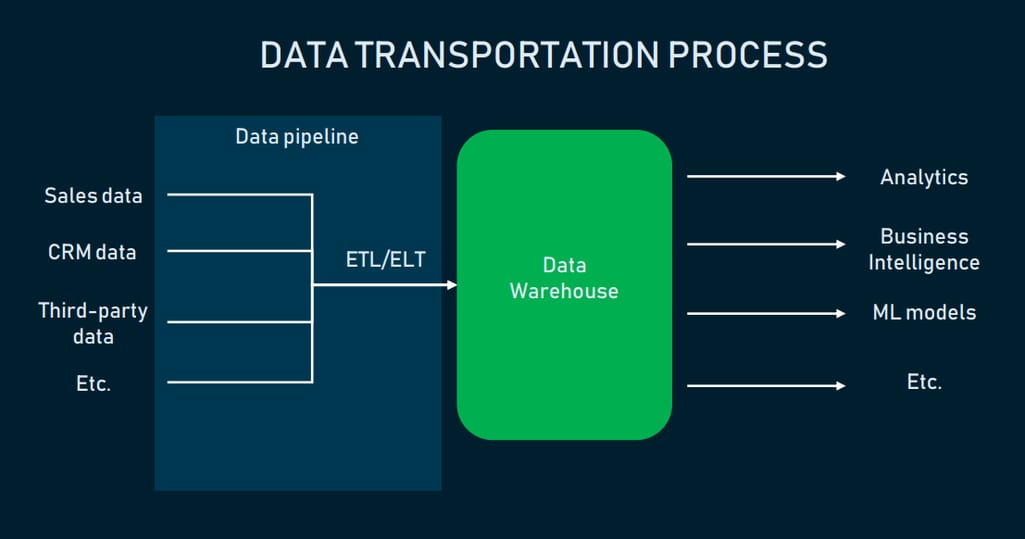
Transporting data from local repositories into a warehouse
Data virtualization uses data abstraction to create a unified view of data for customers, no matter where it resides. In this case, there is no need for uniform formatting or a separate database to consolidate information from different sources.
Data analytics and business intelligence: drawing insights from data
Specialist responsible for the area: data analyst, business intelligence analyst, data scientist, marketing analyst
It is easy to get lost in all the data you’ve collected if you don’t have the right tools to help you understand it. Data analytics and BI solutions are the best way to access and interpret data so you can leverage it for improving income.
Business intelligence uses data for better decision-making regarding organizational operations. It summarizes historical data and visualizes it in a way that allows companies to act on it right away. With aggregation, visualization, and careful analysis, BI helps companies improve efficiency in their present operations.
Data analytics is about developing algorithms to discover hidden insights from vast sets of data. These insights can be further used to ensure the data used is safe and protected.
Data quality management: maintaining the health state of data
Specialist responsible for the area: data quality engineer
Roughly, data quality management (DQM) aims at ensuring that data fits specific business requirements. It employs a range of technologies and methods — for instance, the quality of acquired data can be estimated using the data quality dimensions. For this purpose, you can use a Data Quality Assessment Framework.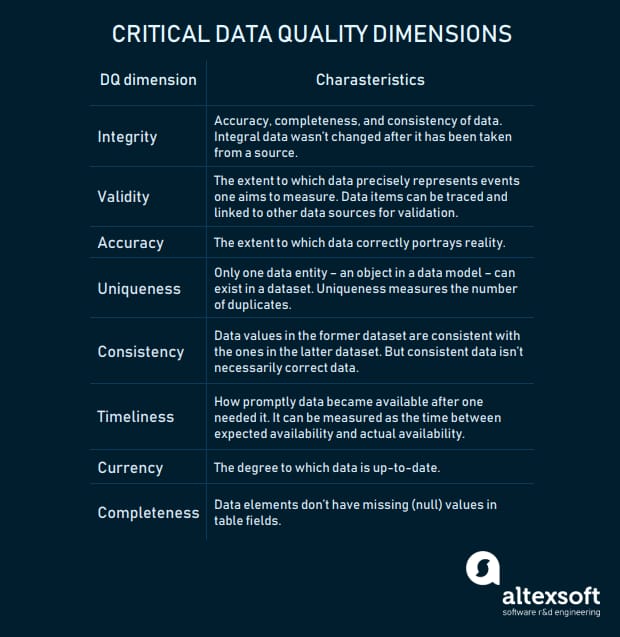
Critical data quality dimensions and features of data that meet their criteria
DQM has a continuous and proactive nature. By ongoing observation, analysis, and improvement of information, DQM maintains the health state of data instead of fixing the consequences of the flawed data. We zoom in on each of the DQM stages in our dedicated article.
Data security: preventing data breaches
Specialists responsible for the area: data architect, data security specialist, database administrator
Data security covers all practices, processes, and technologies preventing unauthorized access to information assets and inappropriate use of them. Among widely-used data security techniques are
- encryption,
- tokenization, or turning sensitive data into strings of identification symbols called tokens,
- access control that regulates who can use company data,
- threat-detection utilizing analytics to spot anomalies in a company’s network, and
- backups to prevent data loss.
A relevant data security plan must consider gathering only the required data, keeping it safe, and erasing information once it is no longer needed. When data is about to undergo either archiving or destruction, it’s necessary to retain data intelligently and avoid redundant archived copies.
Data governance and master data management: ensuring the consistent and efficient use of information
Specialist responsible for the area: data governance analyst
Data governance sets policies and procedures to ensure data is consistent and effectively used throughout an organization. It helps avoid errors, blocks potential misuse of sensitive data, and aligns your business with data-related legislation such as the EU’s GDPR and California’s CCPA.
Data Governance includes Master Data Management. Master data is critical enterprise data related to customers, products, staff, technologies, and materials. Master Data Management ensures its consistent use, fixing any duplicated, incomplete, or controversial data. For instance, it controls that customer names are listed the same in sales, customer service, and logistics departments. MDM activities include accumulating and cleansing data, and its comparison, consolidation, and quality control.
It’s particularly important to create a comprehensive data governance policy. Otherwise, different teams may have their own views on the key data entities, leading to unfortunate controversies.
Data Management Platforms
Data Management Platforms (DMPs) support long-term data management strategies. They bring data to a single platform providing a cohesive view of the business.
Of course, you can utilize warehouses from the biggest cloud vendors like Amazon Redshift, Google BigQuery, and MS Azure SQL Server. However, these solutions are quite difficult to use due to the complexity of their interfaces and the setups involved. So, let’s have a look at the comprehensive cloud computing platforms that make setting up a data management workflow much easier.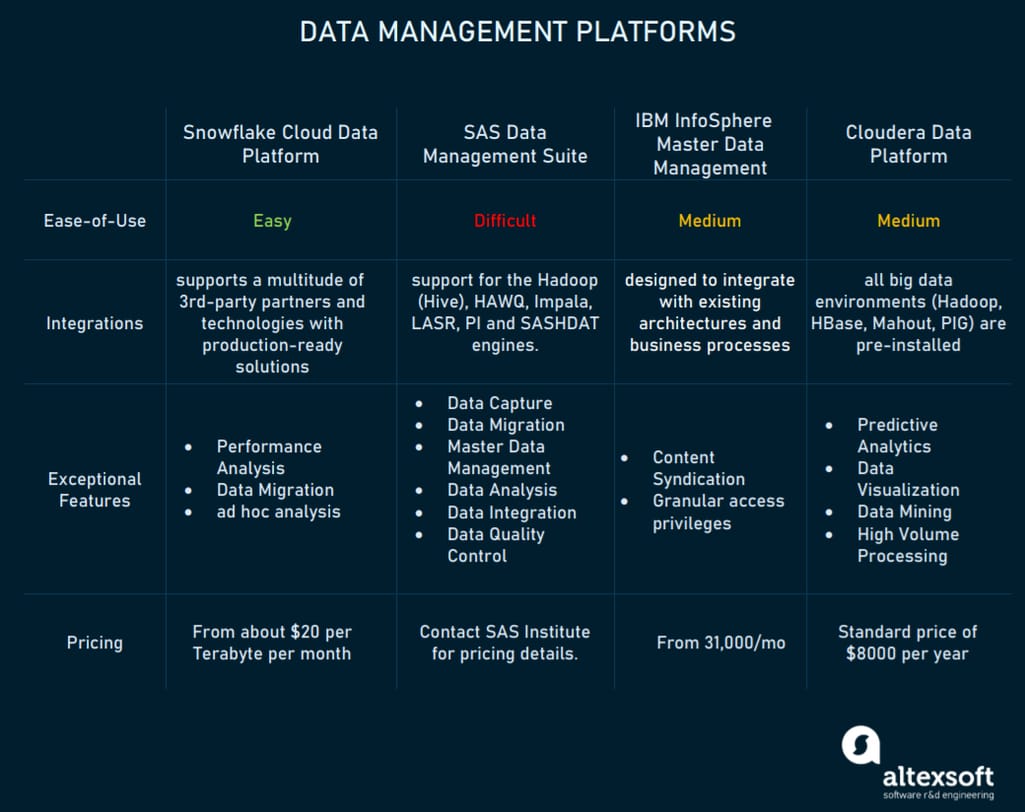
Data Management Platforms compared
The Snowflake Cloud Data Platform: a near-zero management data warehouse
High-speed data management service, Snowflake uses a multi-cloud approach that unites many cloud storages. This way, you can unify, integrate, analyze, and share previously siloed data in secure, governed, and compliant ways. Snowflake provides computing resources scalable for different workloads. As there’s no infrastructure to manage, this DMP is easy to use.
For the complete list of Snowflake integrations, click here.
Snowflake stores all the data in a single solution and performs the following data management operations:
- data warehousing (including data lakes for big data)
- data engineering,
- data science,
- data application development,
- data exchange.
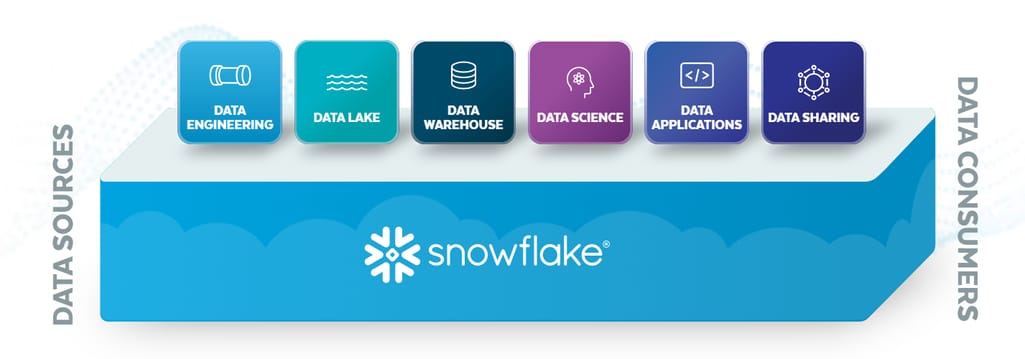
Snowflake data management processes
SAS Data Management Suite: a vast data management marketplace for large businesses
SAS Data Management Suite allows for virtual access to database structures, enterprise applications, mainframe legacy files, text, XML, message queues, and other sources. SAS integrates asynchronous business processes via message-based connectivity. It also contains a built-in business glossary to keep business users and IT experts on the same page.
SAS main features are:
- integrated process designer for building and editing data management processes;
- out-of-the-box SQL-based ETL/ELT capabilities;
- master data management tools;
- data governance and metadata management;
- data migration and synchronization; and
- auditing tools to monitor processing
IBM InfoSphere Master Data Management: a highly configurable framework to manage your enterprise data
IBM InfoSphere Master Data Management coordinates data throughout the complete lifecycle. Both of its editions (Standard and Advanced) are available as either on-premises, hosted, or fully managed cloud offerings.
IBM’s workflow dashboard provides improved user interfaces to create, review, approve, and publish product information, which in turn improves collaboration across the organization. Also, the solution creates a single, up-to-date repository of information that can be used throughout the organization for strategic business initiatives.
The platform includes
- a graph-based exploration of master data, transactional data, and Hadoop;
- built-in hardware and software infrastructure based on IBM Spectrum® Protect, data protection for physical and virtual environments;
- workflow capabilities to implement policies and processes for data governance;
- accurate probabilistic matching and search; and
- comprehensive security with granular access privileges.
Cloudera Data Platform: enterprise data cloud for any data type
Cloudera maintains a high level of scalability, performance, data integrity, and quality. It integrates with many different open-source platforms including Hadoop.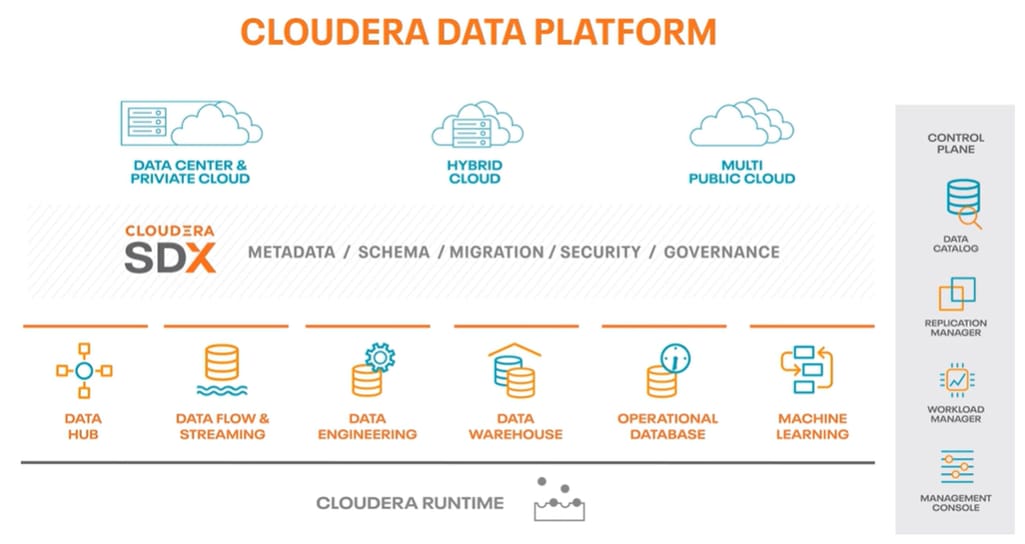
Cloudera Data Platform capabilities
As one of the most complete Data Platforms, Cloudera includes a variety of features like
- alert management,
- cluster management,
- monitoring,
- diagnostics,
- client configuration management, and
- data warehousing in a hybrid multi-cloud.
Among the Cloudera’s partners are Microsoft Azure, IBM, and Red Hat OpenShift container solution.
First steps to implementing a data management strategy
There are certain steps a company has to take while shifting towards a more managed environment. Keeping data managed and reliable is essential for performing qualified data analysis and drawing adequate insights. So, in the end, we list a few important practices that will get your data management ball rolling.
Align your data management with business goals. Before jumping straight in the deep end, outline the goals you want to achieve with the company's data. If you understand what to do with the information, you’ll be able to filter the right data and avoid overcrowding your data management software. For example, if your goal is to find customer buying habits, you’ll focus on the data related to the purchases.
Appoint data management roles. As we’ve figured out, the data management process involves a wide range of tasks, duties, and skills. In smaller organizations with limited resources, individual workers may handle that. But in general, data management professionals include data architects, data modelers, database administrators, database developers, data quality analysts and engineers, data integration developers, data governance managers, and data engineers, who work with analytics teams to build data pipelines and prepare data for analysis.
Ensure data accessibility. While granting access to your company’s data only to those with proper permissions, don’t turn this into a struggle for your authorized personnel. Set up different levels of permissions depending on the specific role or requested data. So, since executives and team leaders need more access to customer data than analysts or sales representatives, they’ll have more permissions.
Produce documentation. By creating data management documentation, you can share valuable skills with the entire team instead of training each employee one by one. Document why the data exists and how it can be utilized.
Adapt to data culture. Developing an internal data culture means adopting a mission to improve your organization using data. Some of the pillars that form a data culture are:
- instilling confidence in data,
- realizing the value of data assets, and
- forming a community to share the best data practices.
By 2025, the amount of digital data generated annually across the globe is estimated to reach 175 zettabytes. How much is that in more familiar units? According to the Data Age 2025 report, to store all this information on DVDs, you need a stack of disks that could circle Earth 222 times. Businesses have two options — leave all these tremendous volumes of data idle or manage it and reap its benefits. The right choice seems pretty obvious.

